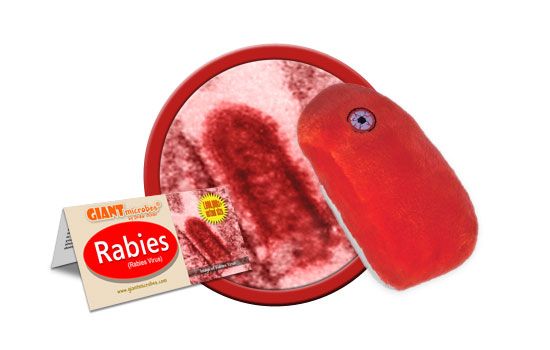Rabies (Rabies Virus)
Out of Stock
Product Details
Additional Information
| Sizes | Giantmicrobes are based on actual microbes, cells, organisms and other critters, only 1,000,000 times actual size! Gigantic (GG) 16-24" XL (XL) 10-15" Original (PD) 5-8" Keychain (KC) 2-4" with clip |
|---|---|
| Materials | Plush from all new materials. Stuffed with polyester fiber fill. Surface washable: sponge with water & soap, air dry. |
| Packaging | Each plush microbe includes a printed card with fun, educational and fascinating facts about the actual microbe or cell. |
| Safety | Every product meets or exceeds U.S. and European standards for safety. For ages 3 and up. |
All about Rabies (Rabies Virus)
FACTS: According to the famous song by Noel Coward, only mad dogs and Englishmen go out in the midday sun – but at least the dogs may have an excuse. In its latter stages, rabies causes fever, insomnia, hallucinations, foaming at the mouth, and extreme aggression.
Rabies is present in the saliva of infected animals, and biting is the primary means of transmission, which is one reason mad dogs have been a source of terror since ancient times. (The other reason is their teeth.) After infection, it generally takes 3 to 12 weeks for the virus to spread through the nerves to the spinal cord up toward the brain.
Once symptoms begin, death is inevitable. However, proper treatment during the incubation period can cure the disease, a discovery made by Louis Pasteur in 1885 when he used his newly developed vaccine to save a boy bitten by a rabid dog. Since Pasteur’s discovery, the death rate from rabies has dropped 99%; 10 million people per year now receive post-exposure preventative treatment.
While the treatment is painful and expensive, an abundance of caution is certainly justified after an animal bite, particularly where the animal is not available for testing. But why wait to be cautious? Ensure that your pets have the rabies vaccination and all appropriate booster shots; avoid contact with all wild animals and strays; and if an animal does bite you, clean the wound and call your doctor immediately.
| Name | Rabies Virus |
|---|
| Actual Size | Approximately 180 nm long and 75 nm wide |
|---|
| Where It Lives | The rabies virus lives in the brain and spinal cord. |
|---|
| System | People typically get rabies after being bitten by a rabid animal. Rabies may sometimes be transmitted if infectious material from a rabid animal, such as saliva, gets directly into the eyes, nose, mouth, or a wound. |
|---|
| Cure | Vaccines for rabies is available, including a rabies post-exposure vaccine. If bitten, the best immediate cure is to clean the wound. |
|---|
| Deadliness/Severity | Rabies can be incredibly lethal if not attended to right away. In fact, the infected animal typically dies within 7 days of becoming sick! |
|---|
| Infectiousness | Any mammal can get rabies. Rabies can be transmitted from animal to animal or animal to human! |
|---|
| History |
Rabies was understood even back in ancient times. Even Aristotle understood that rabies affected dogs and could be transmitted to any animal that the dog bites! During the 18th century, countries such as Germany, France, and Spain tried to eliminate rabies by putting the destruction of stray dogs into law. In the 19th century, quarantines were used to stop the spread of the disease. (Quarantine means to keep a person or animal with a disease away from others to stop the spread of the disease.) In the 20th century rabies was greatly reduced from many developed, mainly because of the rabies vaccination. |
|---|
| Fascinating Facts |
Half of the people who die from rabies are under the age of 15. The word rabies originated from a Latin word, which means “to rage”, since animals seem to act angry when rabid. |
|---|






